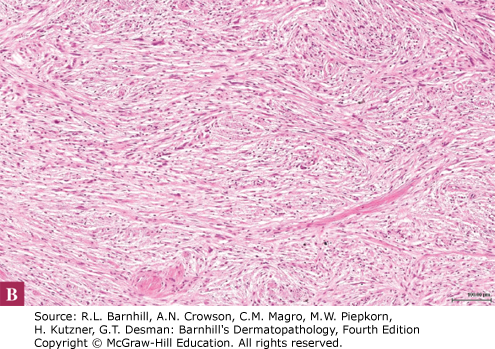Dermatology Question of the Week: Deductive Dermpath

A 50-year-old woman presents with an indurated, violaceous plaque on her thigh that has been slowly enlarging over several years. A punch biopsy is performed and histology reveals a dermal-based proliferation of spindle cells arranged in intersecting fascicles seen below.

The tumor cells have elongated nuclei, scant cytoplasm, and mild pleomorphism. Immunohistochemistry reveals that these tumor cells are positive for S100 and SOX10 but negative for desmin and CD34. What is the most likely diagnosis?
A. Neurofibroma
B. Spindle cell melanoma
C. Leiomyosarcoma
D. Dermatofibrosarcoma protuberans
E. Atypical fibroxanthoma
Rationale: This question focuses on the ability to identify spindle cell neoplasms based on histologic morphology and immunohistochemical staining patterns. Frequently, immunohistochemical stains are utilized to differentiate between various spindle cell neoplasms due to their similar appearance on H&E alone.
Correct answer: B. Spindle cell melanoma
The combination of spindle cell morphology, S100 and SOX10 positivity, and negativity for other markers strongly supports the diagnosis of spindle cell melanoma.
Incorrect answers:
A. Neurofibromas can be S100 positive, are typically negative for SOX10, and typically lack the intersecting fascicles and pleomorphism noted in the patient's biopsy.
C. Leiomyosarcoma is a spindle cell neoplasm characterized by pleomorphism, cigar-shaped nuclei within spindle cells, lacks S100 or SOX10 expression and is usually smooth muscle actin positive and desmin positive.
D. Dermatofibrosarcoma protuberans (DFSP) is a spindle cell tumor that classically has a storiform pattern and is typically CD34 positive.
E. Atypical fibroxanthoma (AFX) is a spindle cell tumor that lacks S100 and SOX10 positivity. Clinically, lesions are typically seen in sun-damaged locations of elderly patients. AFX can have significant pleomorphism and atypical mitoses.
Additional reading at Barnhills' Dermatopathology Chapter 27: Tumors of Melanocytes

Create a Free MyAccess Profile
AccessMedicine Network is the place to keep up on new releases for the Access products, get short form didactic content, read up on practice impacting highlights, and watch video featuring authors of your favorite books in medicine. Create a MyAccess profile and follow our contributors to stay informed via email updates.